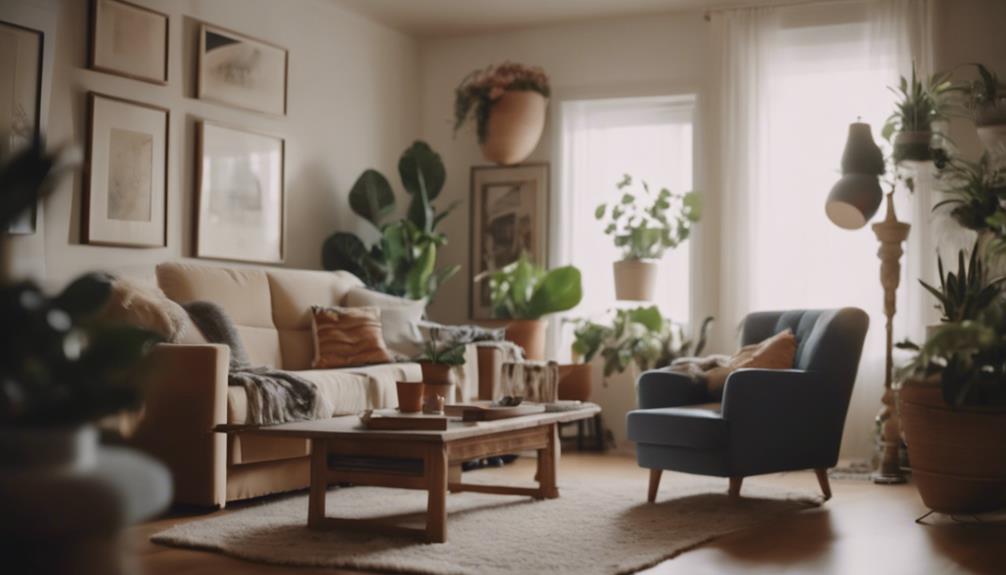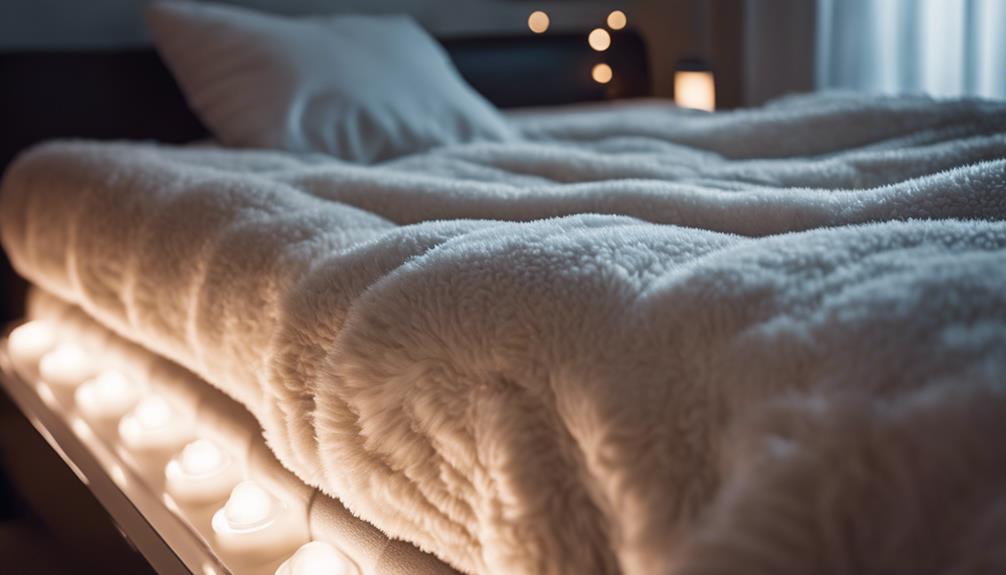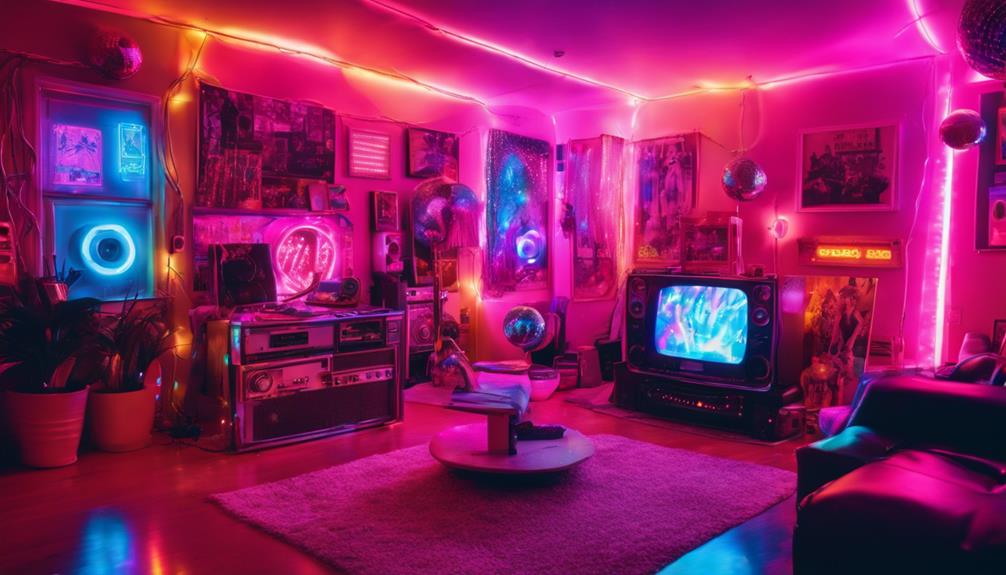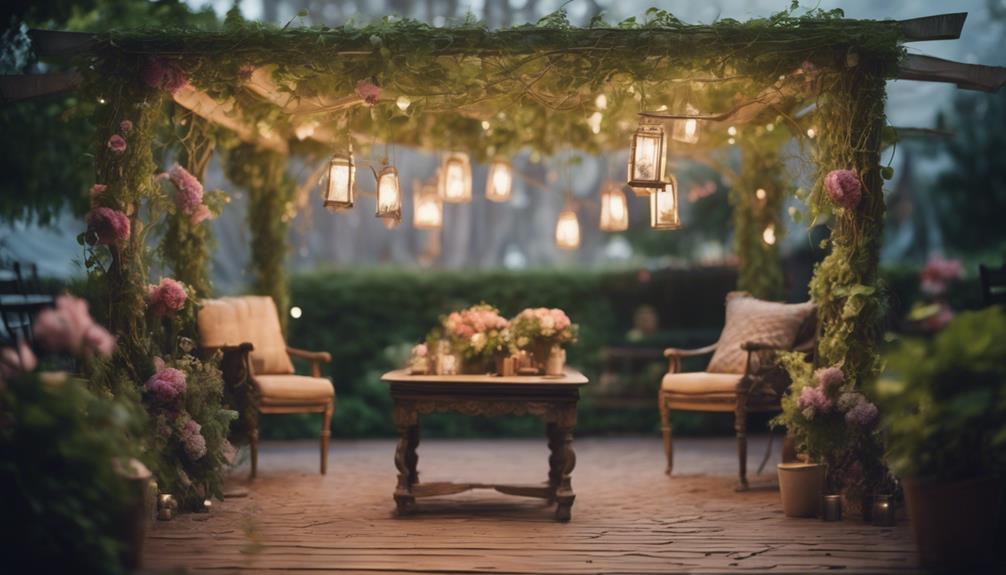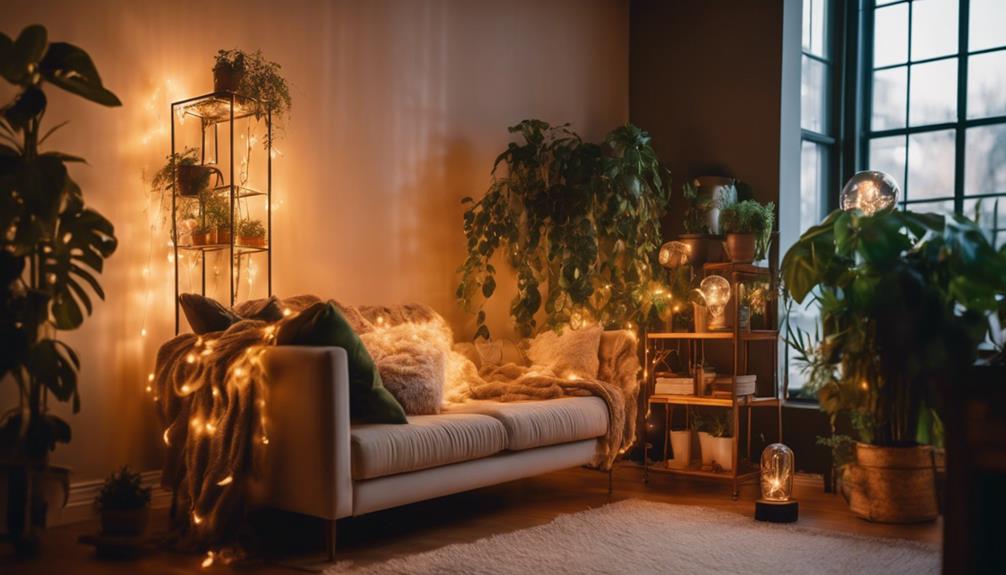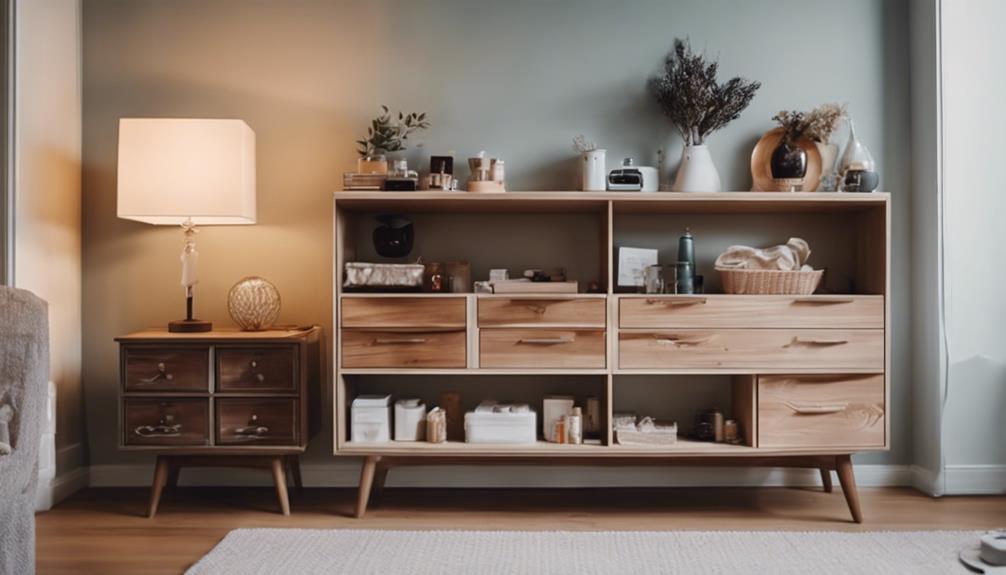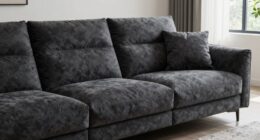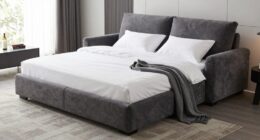When it comes to home decor, it includes furniture, accessories, and color schemes that enhance the aesthetics, ambiance, and emotional well-being of a living space. This process goes beyond just looks; it's about creating a crucial environment that showcases personal style and creativity. Home decor allows for self-expression, improves functionality and organization, and plays an essential role in shaping the mood and atmosphere of a home. Want to explore even more about home decor, including styles, trends, and tips to personalize your space? There's a wealth of information waiting for you to discover.
Key Takeaways
- Home decor includes furniture, accessories, and color schemes to create a harmonious and personalized living space.
- It goes beyond aesthetics to reflect personal style, enhance emotional well-being, and improve functionality.
- Home decor shapes mood, ambiance, and transforms a house into a warm and welcoming environment.
- It involves selecting furniture, adding accessories, choosing color schemes, incorporating reflective surfaces, and green elements.
- Different styles like modern, traditional, contemporary, farmhouse, and bohemian influence home decor choices.
Definition of Home Decor
Home decor refers to the arrangement of furniture, accessories, and color schemes that enhance the overall look and feel of a living space. It goes beyond mere aesthetics, playing an important role in creating a harmonious and visually pleasing atmosphere within a home.
Effective home decor isn't just about style; it also improves the functionality and quality of life in a living space. As trends in home decor evolve over time, they're influenced by various design movements and cultural shifts.
When executed thoughtfully, home decor can serve as a reflection of personal style and creativity. Additionally, well-curated decor has the power to enhance emotional well-being by creating spaces that aren't only visually appealing but also comforting and inspiring.
Essentially, home decor is the art of transforming a house into a home, where every element works together to create a space that's both beautiful and functional.
Purpose of Home Decor
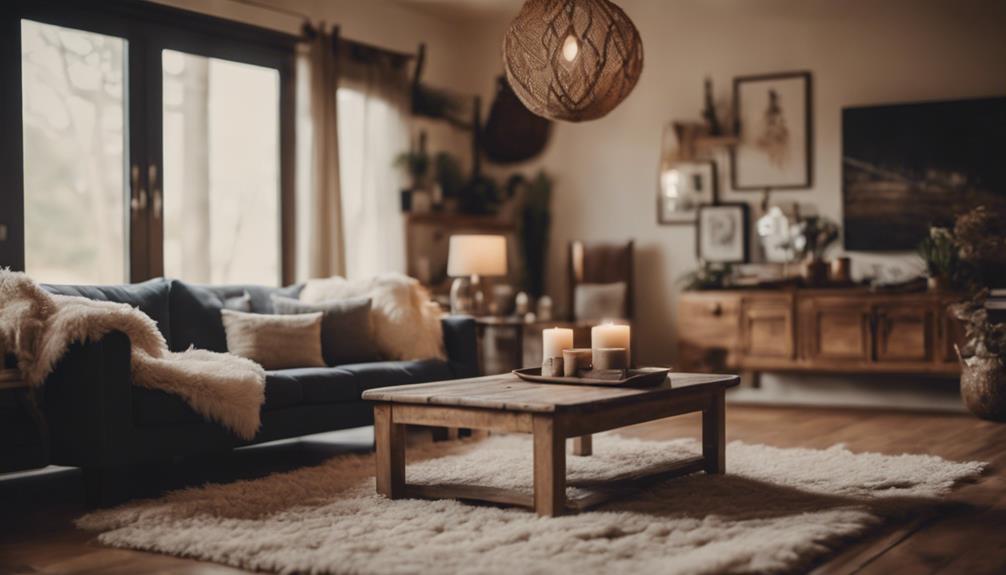
Enhancing the aesthetics and ambiance of a living space is the primary purpose of thoughtful home decor. It involves carefully selecting furniture, accessories, colors, and textures to create a cohesive design that not only looks visually appealing but also feels comfortable to live in.
By expressing personal style through design choices, home decor allows individuals to showcase their preferences and uniqueness. Effective home decor goes beyond just looks; it can also enhance functionality, organization, and overall comfort within a home.
When done well, home decor plays an important role in creating a welcoming atmosphere for both residents and guests. Ultimately, the purpose of home decor is to transform a house into a home, reflecting the personalities and tastes of those who live there. It's a creative outlet that allows individuals to curate their living spaces in a way that brings them joy and satisfaction.
Elements of Home Decor
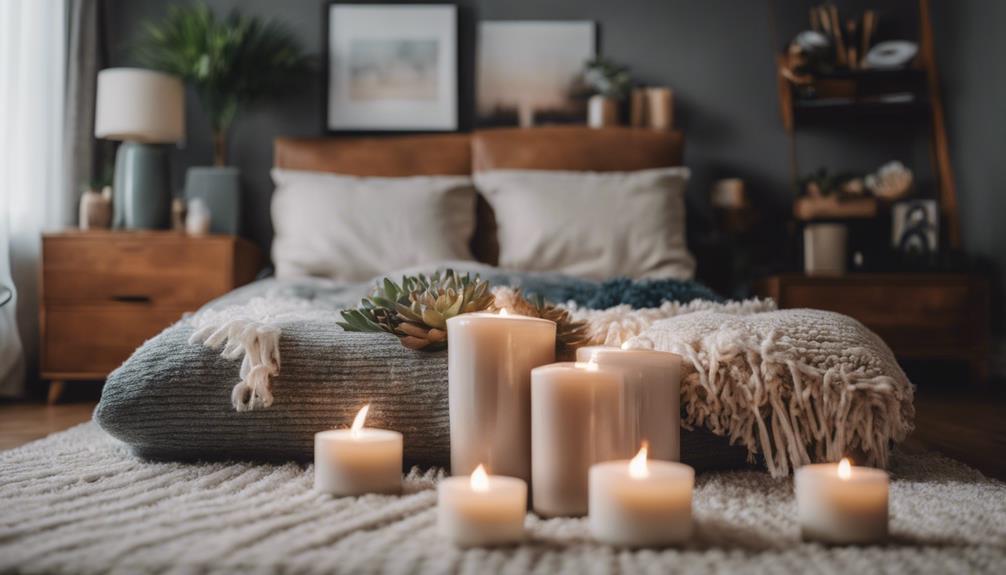
When contemplating home decor, one must take into account the various elements that contribute to the overall aesthetic and ambiance of a living space. Here are some key elements to ponder:
- Furniture: The selection of furniture, such as sofas, chairs, and tables, plays a significant role in defining the style of a room.
- Accessories: Items like cushions, vases, and decorative accessories add personality and charm to a space.
- Color Schemes: Choosing the right colors for walls, furniture, and decor items can greatly impact the atmosphere of a room.
- Reflective Surfaces: Mirrors are often used to create the illusion of space and bring in light, enhancing the overall look.
- Green Elements: Indoor plants in stylish vessels not only add a touch of nature but also contribute to a sense of tranquility and beauty in a room.
Incorporating these elements thoughtfully can help you create a space that truly reflects your personal interests and style.
Importance of Home Decor
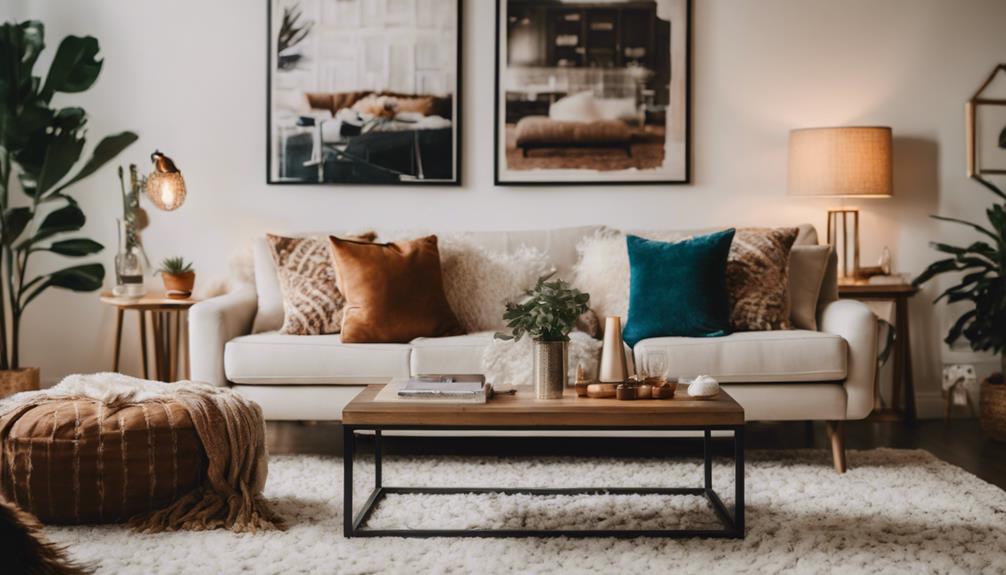
Considering the impact of home decor on mood and ambiance, it becomes evident that the choices made in decor greatly shape the overall living experience. Home decor plays a vital role in transforming a house into a warm and inviting space, where individuals can relax and unwind.
By carefully selecting decor elements, one can create a harmonious environment that reflects their personality and style preferences. Additionally, quality home decor items not only enhance the functionality of a room but can also make a small space feel more spacious and welcoming. Investing in well-designed decor not only benefits the current occupants but also adds value to the property, making it more attractive to potential buyers in the future.
Personalizing home decor allows for creative expression and the opportunity to tailor the living space to individual tastes. Thoughtfully chosen decor pieces can complement the architectural features of a home, elevating its overall aesthetic appeal and creating a cohesive look. Ultimately, home decor serves as a powerful tool in shaping the atmosphere and enhancing the living experience within a home.
Styles in Home Decor
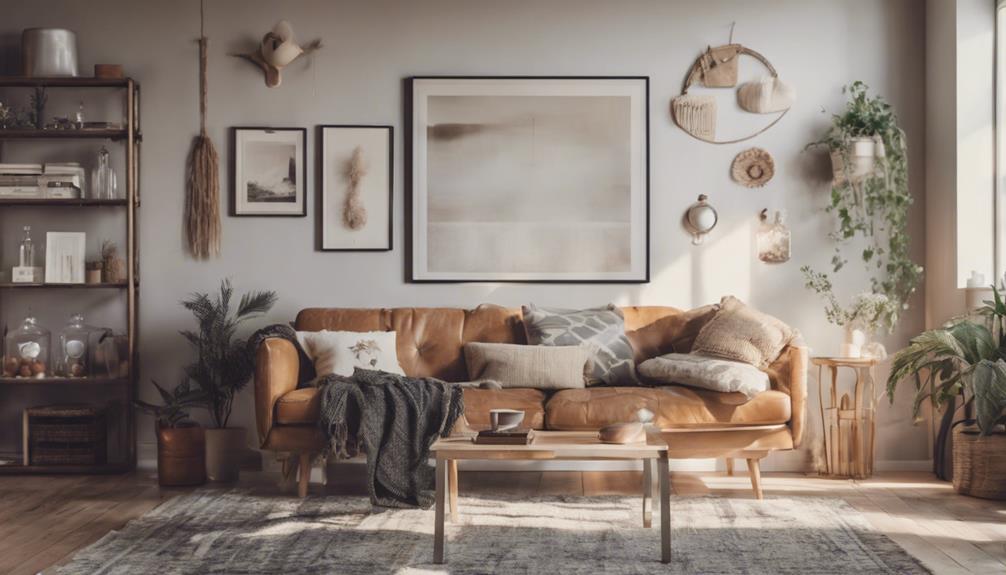
When it comes to home decor, there are various popular styles to choose from, each with its own unique characteristics and design elements. Understanding these styles can help create a personalized touch in your living space, blending timeless design elements with modern aesthetics.
Popular Decor Styles
What distinct design elements and aesthetics characterize popular decor styles in home decor?
- Modern: Clean lines, minimalistic furniture, simplicity, and functionality.
- Traditional: Classic furniture, rich colors, ornate details, timeless and elegant look.
- Contemporary: Current design trends, neutral colors, sleek furniture, innovative materials.
- Farmhouse: Rustic elements, vintage pieces, cozy textures, warm and inviting atmosphere.
- Bohemian: Eclectic mix, vibrant colors, global-inspired patterns, natural elements, relaxed and artistic vibe.
Timeless Design Elements
Timeless design elements in home decor encompass a range of classic styles that feature clean lines, natural materials, rustic finishes, minimalism, and elegant details. Styles like mid-century modern, industrial, farmhouse, Scandinavian, and traditional fall under this category.
These design elements offer signature characteristics that create a sophisticated and enduring look, resistant to changing trends. Mixing elements from different timeless styles can bring depth and personality to your decor. They provide a versatile foundation for decorating, allowing for easy updates with trendy accents or seasonal touches.
Personalized Decor Touches
Exploring personalized decor touches in home design allows individuals to infuse their living spaces with unique and meaningful elements that reflect their personal style and essence. Personalized decor can range from family photographs to cherished awards, all contributing to a space that feels distinctly one's own. Creatively displaying these personal items on shelves, walls, and surfaces adds a special touch to home decor. By incorporating meaningful items, a space can truly reflect the occupant's personality, bringing joy and individuality to the environment. Showcasing these personal touches not only enhances the overall ambiance but also allows for the integration of small details and decorative accents that make a house feel like a home.
- Incorporating unique items like photographs, awards, and personal knickknacks to reflect individual style.
- Creatively displaying personal items on shelves, walls, and surfaces can add a personal touch to home decor.
- Utilizing meaningful items in decor can make a space feel truly personalized and reflective of the occupant's personality.
- Personalized decor touches allow for the integration of small details and decorative accents that bring joy and individuality to a space.
- Showcasing personal items in home decor helps create a space that feels distinctly one's own and enhances the overall ambiance.
Trends in Home Decor
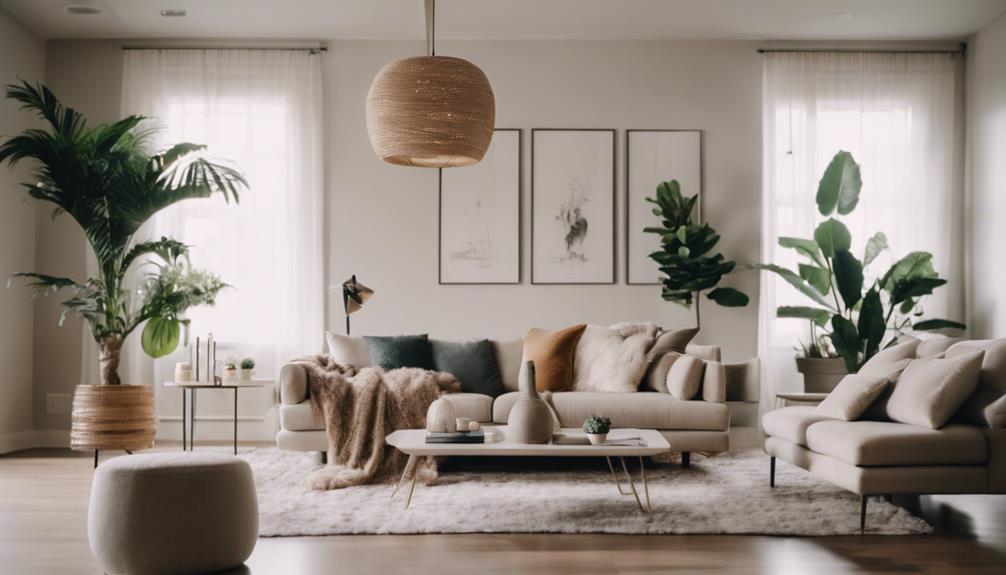
Today's home decor trends are all about incorporating popular color schemes, utilizing sustainable materials, and embracing minimalist design concepts.
These elements come together to create a modern and eco-friendly living environment that reflects current societal preferences.
Popular Color Schemes
When selecting color schemes for home decor, it's essential to consider trends that reflect your personal style and preferences. Here are some popular color schemes in home decor:
- Neutral tones like whites, grays, and beiges for a timeless and versatile look.
- Bold and vibrant colors such as jewel tones like emerald green, sapphire blue, and amethyst purple for striking accents.
- Monochromatic schemes using varying shades of a single color for depth and sophistication.
- Contrasting color combinations like black and white or navy and mustard yellow for visual interest.
- Earthy tones such as terracotta, olive green, and rust are making a comeback, adding warmth and a connection to nature in living spaces.
Sustainable Materials Usage
Shifting focus to the sustainable materials usage trends in home decor, contemporary interior design embraces eco-friendly choices like bamboo and reclaimed wood to promote environmental consciousness and stylish living spaces.
Popular sustainable materials in modern home decor also include recycled glass, cork flooring, organic cotton textiles, and hemp-based furnishings. These materials not only reduce environmental impact but also enhance indoor air quality, creating a healthier living environment.
Minimalist Design Trends
Embracing the essence of simplicity and functionality, minimalist design trends in home decor prioritize clean lines and decluttered spaces. This trend focuses on creating a sense of calm and visual harmony through the following key elements:
- Simplicity, functionality, and clean lines are at the core of minimalist design.
- Neutral color palettes and minimal ornamentation characterize minimalist decor.
- Quality over quantity, open spaces, and natural materials are essential in minimalist interiors.
- Minimalist design promotes organization and a feeling of peace in living spaces.
- Popular in modern interior design, minimalist trends align with the principles of simplicity and less-is-more aesthetics.
Personalizing Home Decor
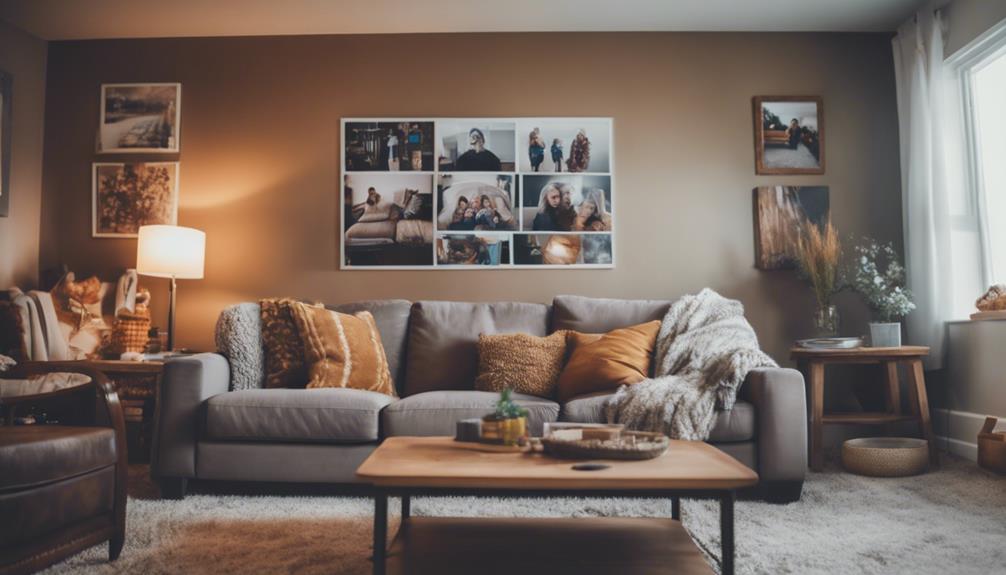
To truly personalize home decor, one must infuse their space with elements that reflect their unique personality and style. Small details and decorative accents play an essential role in showcasing individuality.
Integrating personal items like photographs and awards can add a personal touch to home decor, creating a warm and inviting atmosphere. Another way to personalize your space is by creatively displaying personal knickknacks that match your style, enhancing the uniqueness of your home.
Decorating shelves, walls, and surfaces with items that bring you joy can make your living space feel truly yours. Showcasing meaningful items in your home not only adds a personal touch but also enhances the warmth and personalization of your decor.
Budgeting for Home Decor
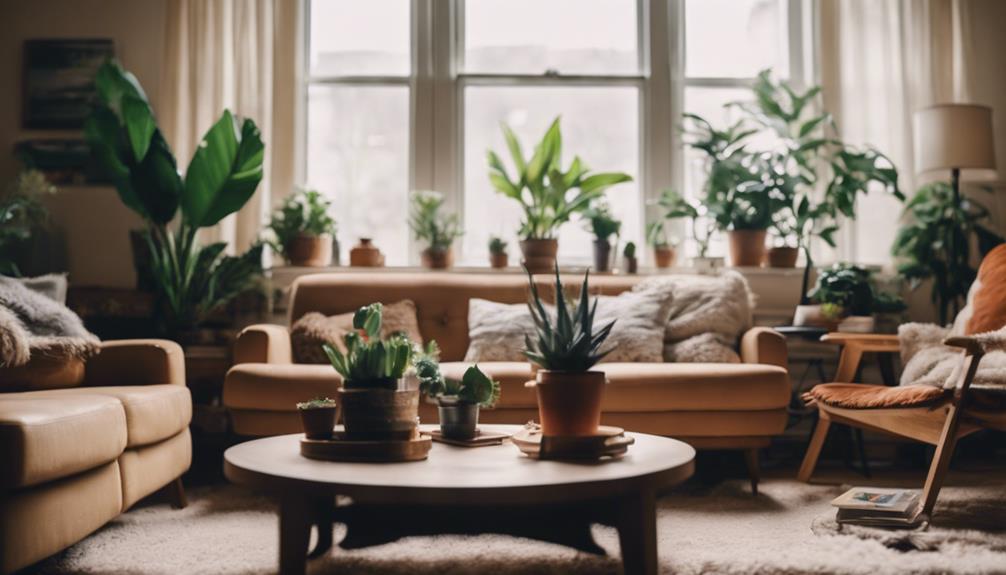
Navigating the world of home decor involves careful consideration of budgeting for our decorative endeavors. When setting a budget for home decor, it's crucial to determine the total amount you can allocate to decor items and accessories. Here are some tips to help you budget effectively:
- Allocate a percentage of your overall home budget, typically around 10-15%, to home decor.
- Research and compare prices of decor items to find affordable options that fit within your budget.
- Prioritize essential decor pieces and invest in high-quality, long-lasting items with a portion of your budget.
- Take advantage of sales, discounts, and DIY projects to maximize your budget and achieve the desired decor look affordably.
- Consider the long-term value of each decor item to make sure that your budget is spent wisely and efficiently.
DIY Home Decor Ideas
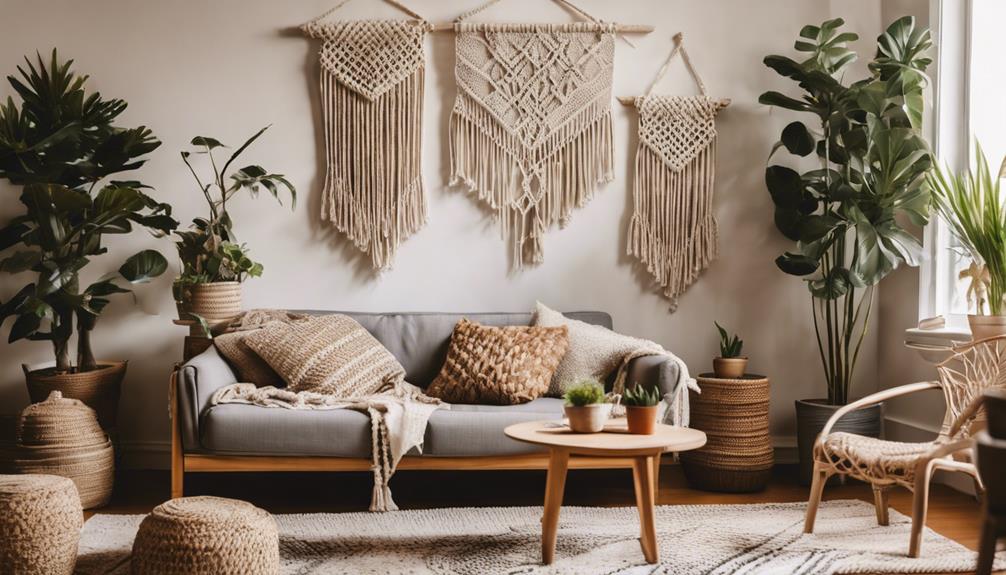
When it comes to DIY home decor ideas, we can explore a world of creativity and personalization. These projects offer a budget-friendly way to decorate our living spaces while adding unique touches.
From crafting personalized wall art to upcycling furniture, DIY home decor allows us to express our style in a fun and rewarding manner.
Creative DIY Projects
Exploring various DIY home decor projects can awaken your creativity and transform your living space into a personalized oasis. Engaging in these projects allows you to add a unique touch to your home without breaking the bank. Here are some creative DIY ideas to get you started:
- Upcycled Furniture: Give old furniture a new life with a fresh coat of paint or unique embellishments.
- Handmade Wall Art: Create one-of-a-kind artwork using canvas, paint, or even recycled materials.
- Customized Shelving: Build your own shelves to display books, plants, or decorative items in a personalized way.
- Repurposed Decor: Turn everyday items like mason jars or crates into stylish decor pieces.
- Textile Crafts: Experiment with sewing or knitting to make custom pillows, curtains, or table runners.
Budget-Friendly Decorating Tips
Let's kickstart our journey into budget-friendly decorating tips by discovering clever DIY home decor ideas that won't break the bank. DIY home decor involves repurposing old items, creating custom art pieces, and using inexpensive materials creatively.
Upcycling furniture, making your own curtains or pillows, and painting walls in a fresh color are great ways to save money while revamping your space. Thrift stores, garage sales, and online marketplaces can be treasure troves for affordable home decor items.
Projects like creating a gallery wall with family photos, crafting personalized wall art, or making unique shelving units can add personality to your home. Incorporating plants, using removable wallpaper, and rearranging furniture are cost-effective ways to update and refresh your home decor.
Personalized Home Accents
Crafting personalized home accents through DIY projects allows us to infuse our living spaces with unique touches that reflect our individual style and creativity. When it comes to DIY home decor ideas, personalized accents offer a special way to showcase your personality.
Here are some examples to inspire your next project:
- Custom photo frames
- Hand-painted wall art
- Upcycled furniture pieces
- Handmade candles
- Furniture restoration
These personalized home accents not only add a distinct flair to your decor but also create a sense of warmth and individuality in your home. By incorporating these DIY projects, you can transform your living space into a truly personalized sanctuary.
Home Decor Shopping Tips
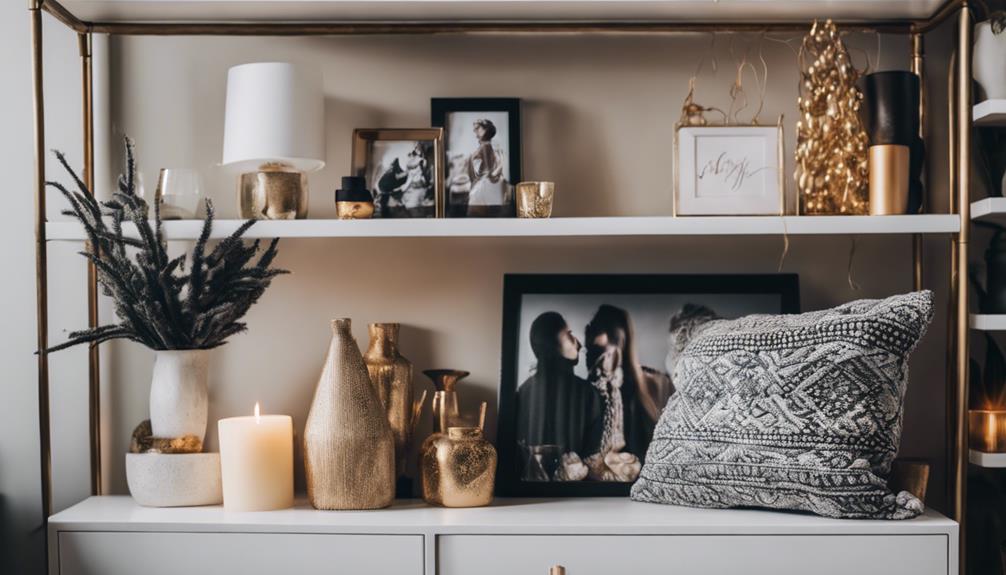
When shopping for home decor, it is important to ponder the room's purpose and choose a unifying theme for a cohesive look. Considering factors like functionality, desired ambiance, and existing furniture can guide your decor choices. Here are some home decor shopping tips to help you create a harmonious living space:
| Tip | Description | Example |
|---|---|---|
| Room's Purpose | Determine how the room will be used to select appropriate decor items. | Bedroom – focus on relaxation and comfort. |
| Unifying Theme | Choose a theme or color palette to tie the room together for a cohesive look. | Coastal theme with blue and white hues. |
| Consistency | Maintain consistency in color schemes, styles, and textures throughout the space. | Match wood tones for a unified feel. |
| Personalization | Add personal touches like family photos or souvenirs to make the space unique and meaningful. | Display a gallery wall of cherished memories. |
| Seasonal Changes | Consider rotating decor items based on seasons to keep the space fresh and inviting. | Swap out cozy blankets for light throws in summer. |
Frequently Asked Questions
What Falls Under Home Decor?
When considering home decor, we look at various elements that enhance our living spaces. This includes furniture, accessories, color schemes, lighting, textiles, rugs, curtains, wall art, vases, mirrors, and decorative accents.
These items help add personality and style to a room. By carefully selecting and arranging these elements, we can create a cohesive and visually appealing environment that reflects our individual preferences and tastes.
How Do You Define Home Decor Style?
When we define home decor style, we consider the specific design choices that reflect a particular aesthetic in a living space. This includes furniture selection, color schemes, patterns, textures, and layouts.
Each style, like modern, traditional, or bohemian, has its unique characteristics. Elements such as furniture pieces, wall art, lighting fixtures, and textiles all contribute to defining a home decor style.
Individual preferences, cultural influences, and design trends shape these styles.
What Is the Difference Between Home Decor and Interior?
When it comes to the difference between home decor and interior design, home decor focuses on selecting and arranging decorative elements like furniture and accessories to enhance visual appeal.
In contrast, interior design involves planning functional and aesthetically pleasing interior solutions for a space, considering layout and functionality.
While home decor is about personalizing a space with decorative items, interior design focuses on the overall design and functionality of a room.
What Is the Best Description of Home Decor?
Home decor involves selecting furniture, accessories, and colors to enhance a living space's aesthetics and functionality. It plays an essential role in reflecting our style and creating a comfortable environment.
Conclusion
To sum up, home decor is like the icing on the cake of your living space – it adds flavor and personality.
By understanding its definition, purpose, elements, importance, styles, and ways to personalize on a budget, you can transform your home into a unique reflection of your taste and style.
With DIY ideas and smart shopping tips, you can create a space that truly feels like home.
So go ahead, let your creativity shine through in your decor choices!
